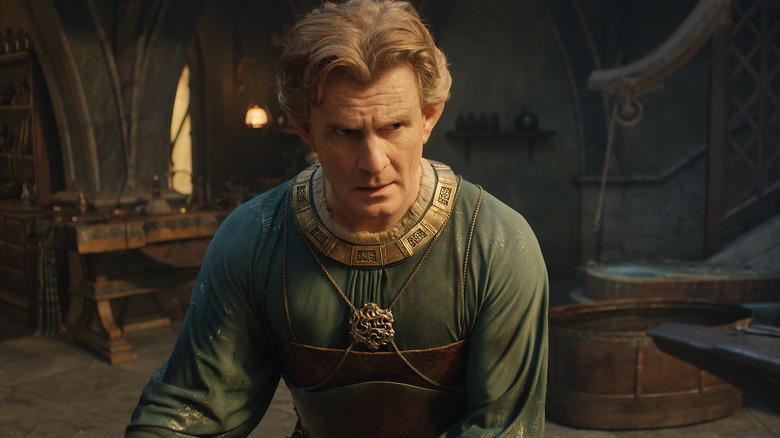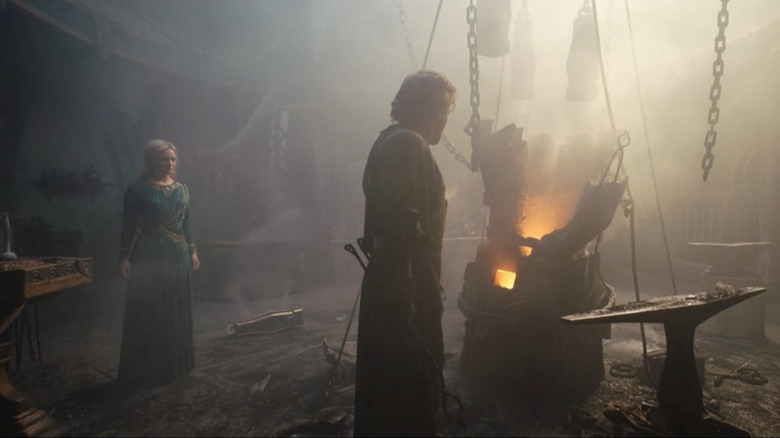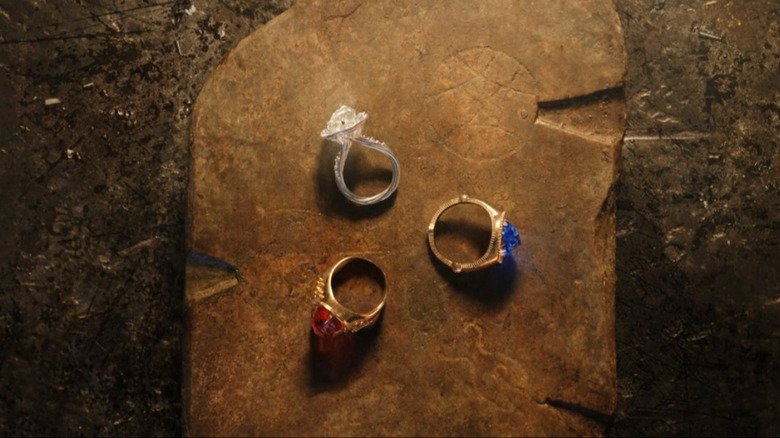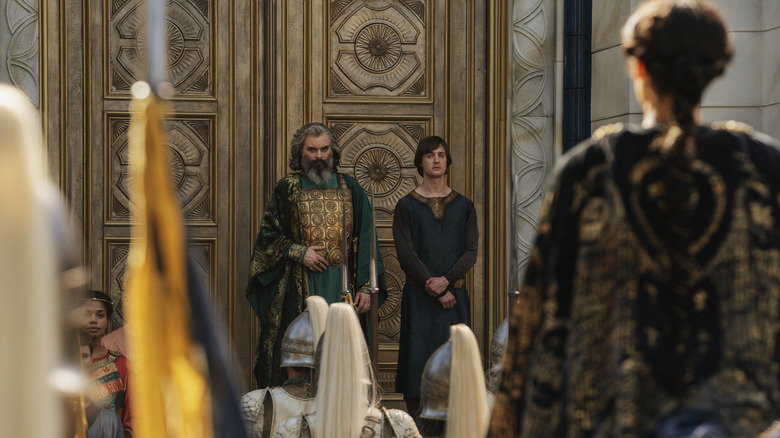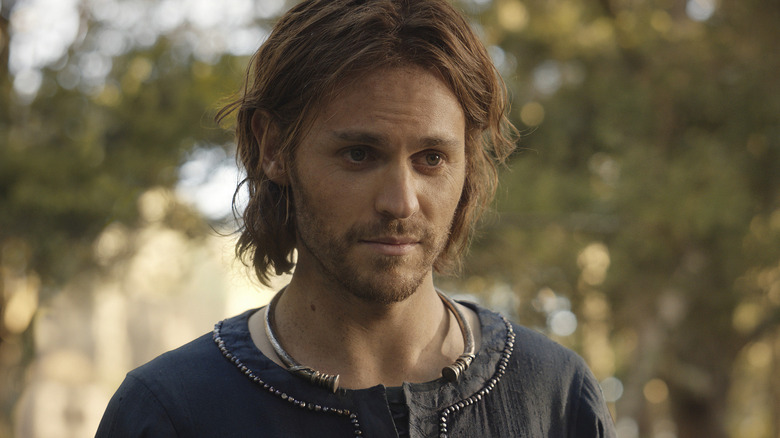Why Rings Of Power Season 1 Changed The Tolkien Timeline
"The Lord of the Rings: The Rings of Power" is a massive series, no matter how you slice it. The show tackles an entire age of J.R.R. Tolkien's world. It weaves together events in the realms of Dwarves, Elves, Men, and Orcs. It brings dozens of characters together in multiple storylines that span the Middle-earth continent and even go well beyond its shores.
The source material is sparse for this period, as well, which has led the "Rings of Power" writing team to fill in many gaps — for better and for worse. On one side of the ledger, we have additions like Disa, a fiery Dwarven princess who fills in a glaring gap in Tolkien's lore. The Harfoots are another warm-hearted "backfill" part of the storyline that details the mysterious and unknown origin of Hobbits.
In contrast to these positive elements, there are some less exciting additions to the lore, like the forced connection of mithril to the Silmarils. Let's not forget the introduction of the Balrog into the story far too early in the Middle-earth timeline, too. One of the biggest head-scratchers from Season 1, though, is when the Three Elven Rings are forged first out of all the Rings of Power. In contrast, Tolkien has the Elves (secretly helped by Sauron) create the Rings for Men and Dwarves first, with the Elven Rings coming last, just before Sauron makes his own One Ring.
Speaking to Inverse shortly after the end of the show's Season 1 finale, writer Gennifer Hutchison explained why the team chose to reverse the order of the forging. "So much of the season was about the elves and their journey, and Galadriel's journey, and the fading [of Eregion]," she said. "So, we wanted to tie those rings into that story."
Hutchison and company were trying to reign in the narrative
Despite the plethora of storylines and activities tackled in Season 1, it's easy to see that the Elves are the center of the story. The show starts with Galadriel narrating an extremely summarized version of the events of "The Silmarillion" — a book that focuses primarily on the fortunes and history of the Elves. After that, we spend a copious amount of time in the Elvish realms of Lindon and Eregion. Even when the narrative wanders its way into Khazad-dûm, the Southlands, and Númenor, we often see these areas through the eyes of Elves like Elrond (Robert Aramayo), Arondir (Ismael Cruz Córdova), and Galadriel (Morfydd Clark), respectively. Everywhere you look, it's clear. The Elves are the central part of the story throughout the first eight episodes.
However, that doesn't mean it's easy to keep things focused. On the contrary, there is so much going on in Season 1, that Gennifer Hutchison added, "It was about narrowing our focus down on [the Elves, their journey, Galadriel, and the fading of Eregion] and having those rings cap off the season. Because we had to make rings. It felt like the climax of that arc, as opposed to trying to manage the timeline in a different way."
To be fair, the busyness of Season 1 hardly would have benefitted from the forging of 16 more Rings of Power (nine for Mortal Men and seven for the Dwarf-lords). It would have only made things feel more rushed — a fact that would have been unappealing to the mass of casual viewers who were already trying to keep up with the complex lore of J.R.R. Tolkien's world.
What is the order of the Ring forging in the source material?
In the source material, these rings are originally Elvish creations as they hone their craft. It's only later that they end up in the hands of the Men and Dwarves through events that the show will likely explain at some point. Without giving too much away, though, the text makes it clear that the 16 rings that end up with Dwarves and Men come first. "The Silmarillion" explains that "Now these were the Three that had last been made, and they possessed the greatest powers."
The Three Elven Rings are also important in the books because they're made without Sauron's help. The above text addresses this by adding, "Therefore the Three remained unsullied, for they were forged by Celebrimbor alone, and the hand of Sauron had never touched them."
To summarize, in Tolkien's writings, the Three Elven Rings come last, are the strongest, and are made without Sauron. In the story told by "The Rings of Power," they come first, and Sauron is at least present and verbally helping forge them, even if he doesn't physically touch them.
While this isn't a deal breaker for most fans, it's a hiccup in the traditional storyline that the show will need to address. Gennifer Hutchison and the rest of the writing room must come up with a believable alternative in the ring-forging order if they want their adaptation to remain compelling and at least loosely tied to the source material.
What ring races could be the focus next?
While the deviation from the Ring-making order is unexpected, Gennifer Hutchison's point still stands. It fits in with the focal point of Season 1, which is the Elves. In a show with a five-season story arc, there is limited time to devote to each part of the story. And there's no doubt that the drama and focus are going to shift to other groups before long. The question is, which ring-wielding race will come into the show's narrative crosshairs next?
There are two primary options: Men and Dwarves, the former of which should play a huge role going forward. The Númenóreans will go through a series of dramatic Atlantean events before, among other things, they create the kingdom of Gondor and help to topple Sauron and cut the One Ring from his hand. With that said, Númenor has the potential to be a slow-burn story. It will be pivotal in the final act of the show, which means it may not feature too heavily until Season 3 or beyond.
The Dwarves don't play a huge part in Tolkien's Second Age (when the show is set). However, the introduction of the Balrog in Season 1 demonstrates that the show's creators are willing to pull events forward thousands of years before they take place in Tolkien's original writings. This could mean the Durins of Khazad-dûm have a bigger part to play before long. And that doesn't even consider the fact that Khazad-dûm's primary part in the Second Age source material takes place when Sauron attacks the doomed Elves of Eregion, which looks likely to happen in Season 2. Realistically, both Men and Dwarves could take the spotlight next. Maybe we'll even see both groups receiving Rings simultaneously before long.
Respecting Tolkien's timeline isn't a factor for Rings of Power
The question of the correct order in which to forge the Rings of Power — and the show's deviation from that canon timeline — shouldn't be a surprise. Well before the first episode aired, showrunner J. D. Payne warned that the show was going to deviate from Tolkien's books in general. "If you are true to the exact letter of the law, you are going to be telling a story in which your human characters are dying off every season because you're jumping 200 years in time, and then you're not meeting really big, important canon characters until season four," he said.
The Second Age story that the show is telling is technically 3,500 years long in the source material. Over that massive span of time, entire kingdoms of Men are founded before they eventually perish. Elven kingdoms are set up and grow old. Epic wars are fought centuries apart. Heck, the timeline in the appendices to "The Return of the King" says that Sauron starts helping the Elves forge Rings of Power 1,500 years into the age ... and doesn't create the One Ring for another century.
This works in Tolkien's wonderfully historical style, but for a fast-paced television show, it feels more like a documentary than a drama.
The deviation in Ring forging is an unfortunate necessity that "The Rings of Power" team opted to take to keep their Elf-centric Season 1 storyline on track. Hopefully, they can introduce the rest of the Rings of Power soon, though, and speed up the story's sluggish start as their show begins moving toward some of the most dramatic, tragic, and heroic events in all of Middle-earth history.
